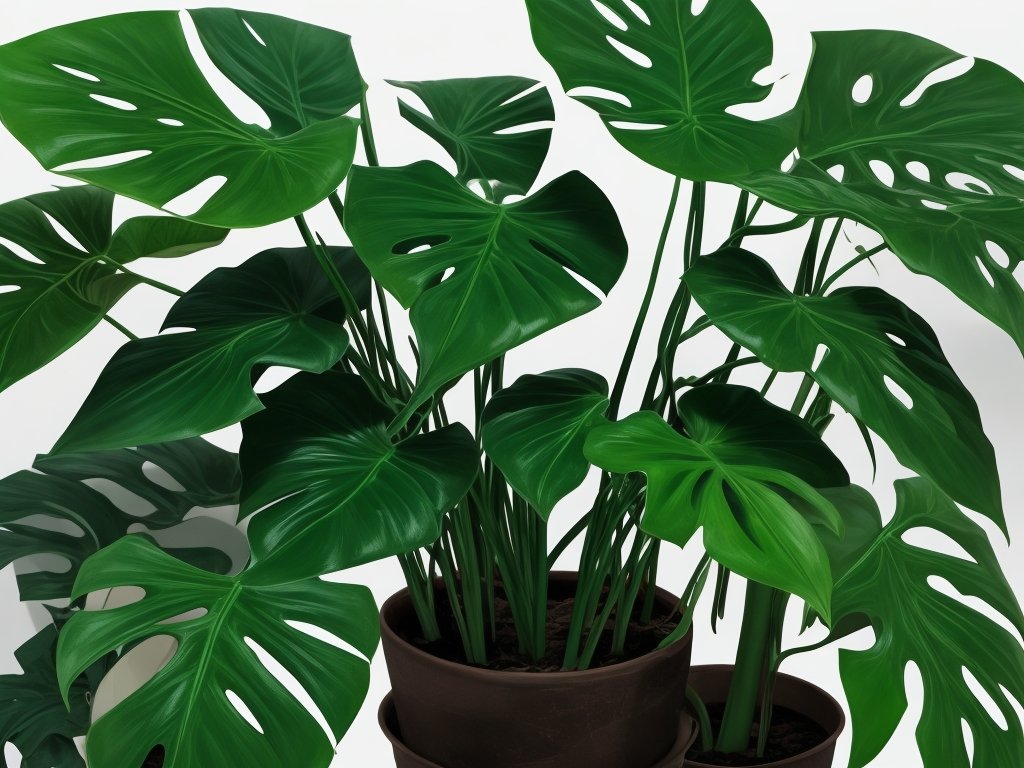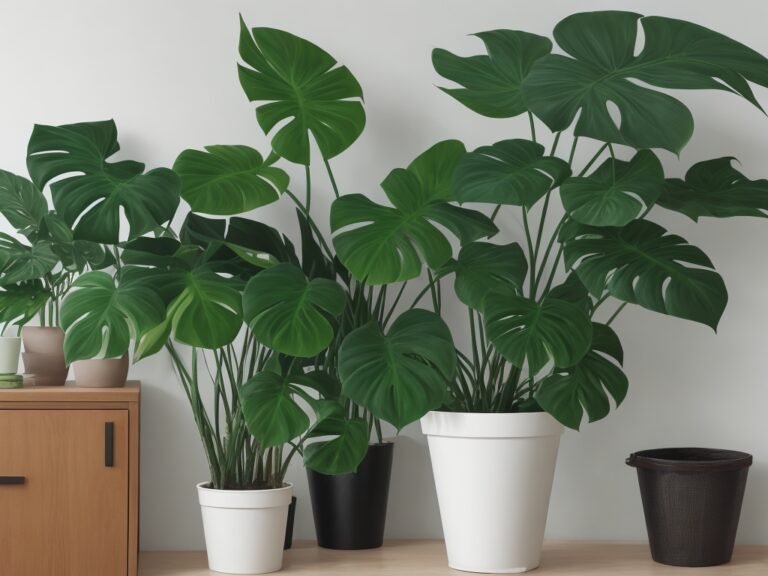Best Ways To Increase Monstera Leaf Fenestrations – Unveil the secrets!
Key Takeaways:
- Increase light exposure to encourage Monstera leaf fenestrations.
- Maintain proper humidity levels for healthier and more fenestrated leaves.
- Avoid over-fertilization, as it can hinder fenestration development.
- Prune older leaves to redirect energy towards new growth and fenestration.
Are you a plant lover looking to take your Monstera’s leaf game to the next level?
Well, you’re in for a treat! Monstera leaf fenestrations are those stunning, natural holes and openings that add a touch of elegance and uniqueness to this popular houseplant.
But how can you increase those delicate leaf perforations and make your Monstera stand out even more?
In this article, I’ll share with you the best ways to enhance and promote Monstera leaf fenestrations.
From providing adequate light and maintaining optimal humidity levels to using proper watering techniques and pruning methods, I’ve got you covered.
Get ready to bring out the true beauty of your Monstera!
| Method | Description |
| Fenestration Promoting Techniques | Specific methods to enhance leaf fenestrations |
| 1. Adequate Lighting | Ensure the plant receives bright, indirect sunlight |
| 2. Optimal Temperature | Maintain temperatures between 65-85°F (18-29°C) |
| 3. Humidity Control | Provide humidity levels between 50-60% |
| 4. Proper Watering | Water thoroughly and allow soil to dry between waterings |
| 5. Soil Type | Use well-draining soil with good organic matter |
| 6. Supportive Staking | Offer support for new growth to encourage fenestrations |
| 7. Leaf Misting | Mist the leaves regularly to enhance humidity |
| 8. Nutrient-Rich Fertilizer | Feed the plant with balanced, organic fertilizer |
What are Monstera leaf fenestrations?
Monstera leaf fenestrations refer to the natural holes or splits that develop in the leaves of a Monstera plant, creating a distinctive and eye-catching pattern. They are a defining characteristic of this popular houseplant.
Definition of Monstera leaf fenestrations
Monstera leaf fenestrations refer to the natural holes or splits that appear on the leaves of Monstera plants. These fenestrations are a characteristic feature of many Monstera species and add to their unique and attractive appearance.
The fenestrations occur as the plant matures and are believed to be an adaptation that helps the plant withstand strong winds and tropical rainforest conditions.
Importance and aesthetics of Monstera leaf fenestrations
Monstera leaf fenestrations are important for the overall aesthetics of the plant. They provide a unique and tropical look, adding visual interest and depth to the leaves.
Fenestrations also allow for better air circulation and light penetration, which can result in healthier and more vibrant foliage.
So, if you’re looking to enhance the beauty of your Monstera plant, fenestrations are definitely worth considering!

Factors affecting Monstera leaf fenestrations
There are three main factors that affect Monstera leaf fenestrations: genetics and species variations, environmental conditions, and nutrient deficiencies.
Genetics and species variations
Genetics and species variations play a significant role in determining the extent of leaf fenestrations in Monstera plants.
Certain species, such as Monstera deliciosa, are known for their naturally occurring fenestrations.
help maintain healthy Monstera leaf fenestrationspecies can also influence the development of fenestrations.
It’s important to keep in mind that not all Monstera plants will have the same level of fenestrations due to these genetic and species variations.

Environmental conditions
Environmental conditions play a significant role in the development of Monstera leaf fenestrations. Here are some key factors to consider:
- Light: Providing adequate light, but avoiding direct sunlight, can promote fenestrations.
- Humidity: Maintaining optimal humidity levels, between 60-70%, helps create favorable conditions for fenestrations.
- Watering: Proper watering techniques, such as allowing the soil to dry between waterings, prevent overwatering and waterlogging.
- Fertilization: Using appropriate fertilizers, specifically those high in phosphorous, promotes healthy leaf development.
- Pruning and propagation: Pruning stimulates new growth, while propagation allows for the growth of new fenestrated leaves.
It’s important to find the right balance in these environmental conditions to encourage the growth of beautiful monstera leaf fenestrations.
Nutrient deficiencies
Nutrient deficiencies can impact the development of Monstera leaf fenestrations.
Lack of essential nutrients like nitrogen, phosphorus, and potassium can result in smaller and less pronounced fenestrations.
It’s important to ensure your Monstera plant receives a balanced fertilizer to avoid these deficiencies and promote healthy growth.
Best ways to increase Monstera leaf fenestrations
Want to increase the fenestrations on your Monstera leaves? Here are some effective methods.
Providing adequate light
Providing adequate light is essential for increasing Monstera leaf fenestrations. Place your Monstera plant near a bright, indirect light source.
Avoid direct sunlight as it can burn the leaves.
Consider placing it near a north or east-facing window or provide artificial grow lights if natural light is limited.
Maintaining optimal humidity levels
Maintaining optimal humidity levels is crucial for healthy Monstera leaf fenestrations. To do this, you can:
- Use a humidifier to increase humidity in the air.
- Group plants together to create a microclimate with higher humidity.
- Mist the leaves regularly with water to provide moisture.
- Place a tray of water near the plant to increase humidity through evaporation.
- Avoid placing your plant near sources of heat or drafts that can dry out the air.
Remember, keeping the humidity levels consistent and appropriate for your Monstera plant will help promote healthy leaf fenestrations.

Proper watering techniques
Proper watering techniques for Monstera plants involve watering them thoroughly and allowing the soil to dry out between waterings.
Avoid overwatering, as it can lead to root rot.
Use well-draining soil and poke your finger into the soil to check moisture levels.
Remember to adjust watering based on seasonal changes and environmental conditions.
Using appropriate fertilizers
Using appropriate fertilizers is essential for promoting healthy Monstera leaf fenestrations.
Look for a balanced fertilizer with equal amounts of nitrogen, phosphorus, and potassium.
Organic fertilizers like compost or worm castings are great options.
Apply the fertilizer according to the package instructions, usually once a month during the growing season.
Avoid over-fertilizing, as it can lead to nutrient imbalances and harm the plant.

Pruning and propagation methods
Pruning and propagation are two effective methods for increasing Monstera leaf fenestrations. Pruning involves cutting back overgrown or damaged leaves, which stimulates new growth and encourages the development of fenestrations.
Propagation, on the other hand, involves taking cuttings from a healthy Monstera plant and rooting them in water or soil.
This method allows you to grow new plants with desirable fenestrations. Both these methods can help promote healthier, more fenestrated leaves in your Monstera plant.
Avoiding overwatering and waterlogging
To avoid overwatering and waterlogging your Monstera plant, it’s important to find the right balance. Here are some tips:
- Check the soil moisture: Before watering, check if the top inch of soil is dry. If it’s still moist, hold off on watering.
- Watering frequency: Water your Monstera plant when the soil has dried out, but don’t let it completely dry out between waterings.
- Proper drainage: Make sure your plant pot has drainage holes to allow excess water to escape. This prevents water from sitting in the bottom of the pot and causing waterlogging.
- Avoid standing water: Remove excess water from saucers or trays underneath your plant to prevent the roots from sitting in water.
- Adjust watering based on environmental factors: Factors like temperature and humidity affect how quickly the soil dries out. So, be mindful of these factors and adjust your watering accordingly.
- Observe plant behavior: Pay attention to your Monstera plant’s leaves and overall appearance. If the leaves start turning yellow or drooping, it may be a sign of overwatering. Adjust your watering routine accordingly.
Tips for promoting healthy Monstera leaf fenestrations
To promote healthy Monstera leaf fenestrations, regularly clean the leaves and protect the plant from pests and diseases. Additionally, avoid temperature extremes and provide proper placement and support for climbing.
Regular cleaning of leaves
Regular cleaning of Monstera leaves is important for their overall health and appearance.
Dust, dirt, and other debris can accumulate on the leaves, blocking sunlight and preventing proper photosynthesis.
To clean the leaves, gently wipe them with a soft, damp cloth or use a mild spray bottle to mist them.
Avoid using harsh chemicals or abrasive materials that can damage the leaves.
By regularly cleaning your Monstera leaves, you can ensure they stay vibrant and free from build-up, promoting healthy growth and fenestrations.
Protecting from pests and diseases
To protect your Monstera plant from pests and diseases, regularly inspect the leaves for any signs of infestation. If you notice pests like spider mites or mealybugs, remove them manually or use organic pest control methods.
Avoid overwatering and maintain good air circulation to prevent fungal diseases.
Keep the plant clean and avoid placing it near other infected plants.
Avoiding temperature extremes
Maintain consistent temperatures between 65-85°F (18-29°C).
Protect your Monstera plant from drafts and avoid placing it near heaters or air conditioning vents.
Sudden temperature changes can cause stress and damage the leaves.
Keep a stable environment to promote healthy leaf fenestrations.
Proper placement and support for climbing
To promote healthy Monstera leaf fenestrations, it’s important to provide proper placement and support for climbing. Place your Monstera near a sturdy support structure, such as a moss pole or trellis, to allow it to climb and grow vertically.
Ensure that the support is tall enough for the plant to reach its full potential.
Secure the stems to the support using soft ties or plant clips, being careful not to damage the stems. Regularly check and adjust the ties as the plant grows.
This will help the plant develop strong aerial roots and encourage the emergence of fenestrated leaves.
Can I grow Monstera in low-light conditions?
Yes, you can grow Monstera in low-light conditions, but it may affect the growth and development of the plant. Monstera plants thrive in bright, indirect light, and will produce more fenestrations (the iconic, leafy holes) in optimal lighting conditions.
If you have low light, consider placing your Monstera near a bright window, or use artificial grow lights to supplement the light.
Just keep in mind that without enough light, your Monstera may grow slower and have fewer fenestrations.
How often should I fertilize my Monstera plant?
For optimal growth, fertilize your Monstera plant every 2-4 weeks during the growing season (spring and summer).
Use a balanced, water-soluble fertilizer and dilute it according to the instructions.
Avoid over-fertilizing, as it can lead to nutrient burn and damage the plant.
What are common pests that affect Monstera leaf fenestrations?
Common pests that affect Monstera leaf fenestrations include spider mites, aphids, mealybugs, and scale insects.
These pests can damage the leaves, causing discoloration, wilting, and stunted growth.
Regular inspection and prompt treatment are essential for maintaining healthy leaf fenestrations.
Can I use tap water for watering my Monstera plant?
Yes, you can use tap water for watering your Monstera plant.
However, it’s important to note that tap water can contain chemicals like chlorine and fluoride that could potentially harm your plant over time.
To minimize any negative effects, you can let the tap water sit out for 24 hours to allow the chlorine to dissipate or use a water conditioner to remove harmful chemicals.
Alternatively, using filtered or distilled water can also be a good option to ensure the health of your Monstera plant.
What are signs of overwatering a Monstera plant?
Overwatering a Monstera plant can lead to several signs, including yellowing leaves, wilting, root rot, and fungal growth.
The leaves may become mushy or develop brown spots.
Additionally, you may notice a musty smell coming from the soil.
It’s important to adjust your watering routine to prevent these issues.
Final Verdict
Monstera leaf fenestrations not only add beauty and uniqueness to these plants, but they also play a vital role in their overall health and growth. By understanding the factors that affect fenestrations and implementing the best practices to increase them, you can promote the development of these striking leaf patterns.
Providing adequate light, optimal humidity levels, proper watering techniques, appropriate fertilizers, and practicing pruning and propagation methods are all effective ways to enhance fenestrations.
Additionally, regular cleaning, protection from pests and diseases, avoiding temperature extremes, and providing proper support for climbing will help maintain healthy Monstera leaf fenestrations. By following these tips, you can enjoy a thriving Monstera plant with beautiful and prominent fenestrations.






